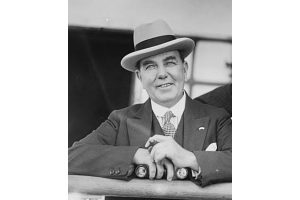Lyn Collingwood, Bulletin 3/2022, May 2022
Richard Orchard was one of the male celebrities sketched in Sydneyites as we see ’em, published in 1915. He was then living at Claremont, 22 Allen St,Glebe, a house which bore that name into the 1940s.
The eighth child of a Cornish blacksmith, Orchard was born on 14 October 1871 at Cockatoo near Maryborough, Victoria. The family moved to Sydney where he worked as a post office messenger boy before joining one of his brothers travelling around rural NSW selling jewellery from a two-horse wagon. They made some extra money staging ‘biopix’ magic lantern shows.
In the 1890s, Orchard started a watchmaking business in Newtown and after two years set up as a jeweller in George St in the city. R. B. Orchard Ltd, jeweller and watchmaker, was floated as a public company in 1913.
With William James Proud and Edmund James Coote, Richard Orchard founded the Retail Jewellers Association of NSW and was president of the Cornish Association of Sydney.

Having run unsuccessfully for the Sydney Municipal Council and the State seat of Hawkesbury, Orchard won the Federal seat of Nepean in 1913 as a Liberal candidate and was re-elected the next year. After another successful campaign in 1917, he joined Billy Hughes’ Nationalist government. He served as a member of the Parliamentary Recruiting Committee before being appointed Assistant Minister for Recruiting (March 1918 to January 1919) and a member of the war and peace loan committees. As chairman of the peace celebrations committee, he recommended that festivities be restricted to two days. Orchard did not contest the 1919 general election. He was appointed CBE in 1920.
The Liverpool military camp for newly enlisted men was situated within Orchard’s constituency. In 1915 Orchard instigated an inquiry into conditions there. The recruits’ complaints included being treated by a doctor whose ancestry was German, and a shortage of greatcoats for those on 24-hour guard duty during winter. More serious were allegations of men being sent to the Front with inadequate training. Not enough bandaging practice was given. A third of the recruits were unfamiliar with rifles, not knowing how to load them or extract a shell. They practised with old weapons but were sent overseas with new ones they didn’t know how to use. One witness testified that casualties at Gallipoli would have been fewer if the men had been trained. Glebe cricketer and recruiting poster pinup boy Tibby Cotter said he’d never been sick in his life before going into the camp. Hygiene was a major problem.
After the inquiry’s recommendations were adopted, Orchard visited the Liverpool camp where Diggers presented him with an illuminated address and carried him shoulder high to his car. In 1916 ‘The Soldier’s Friend’ went to England at the invitation of the Imperial Parliamentary Association and toured the Western Front.

Orchard raced 18-footers in Sydney Harbour and appeared in amateur productions of plays and light opera. A skilled platform speaker, he contested the Federal seat of East Sydney in 1925, banking on the support of single women living in Darlinghurst flats who, according to Punch, would vote for his actor’s charisma. He lost, however, to the ALP’s John West who held the seat from 1910 until his death. In 1928 Orchard stood unsuccessfully for the Senate.
In 1924 Orchard went to England as a government representative to the British Empire Exhibition at Wembley. He was highly critical of a decision to send thousands of cases of Tasmanian apples which would never ripen because they were full of black spot. The Americans, in contrast, would maintain their reputation by always exporting only their best produce.
On the Wireless Advisory Board from 1929, Orchard was a founding Commissioner of the Australian Broadcasting Commission 1932-39. He was a director and president of the Smith Family, and president of the Ku-ring-gai Chase Trust. A Methodist, he died on 24 July 1942 at Darling Point, survived by a son and three daughters and Maria Annie née Austen whom he had married in 1895. Orchard Park at Bobbin Head is named after him.
Sources: Australian Dictionary of Biography; NSW registry of births, deaths, marriages; Trove website.

Posted on 12 June 2022 by Lyn Collingwood
For more information email: heritage@glebesociety.org.au








There are no comments yet. Please leave yours.